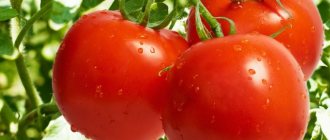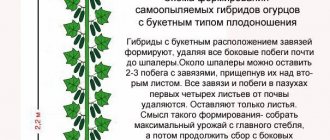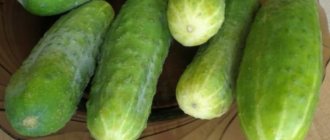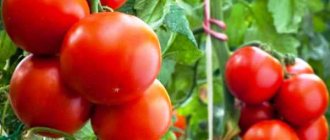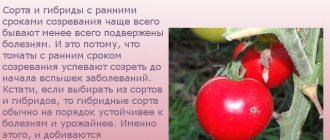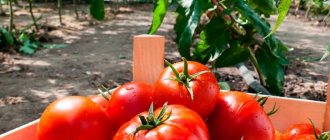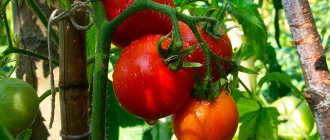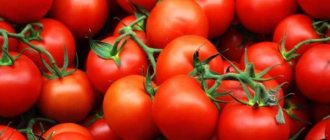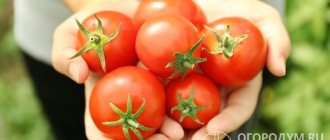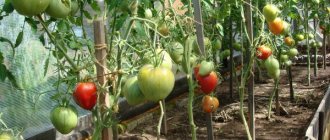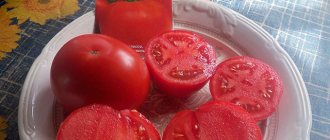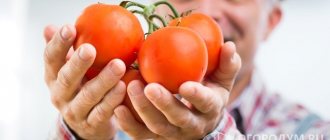Determinate varieties of tomatoes differ from indeterminate ones in that the plants themselves stop growing after the formation of 3 - 5 inflorescences. Although it is possible to form 6 inflorescences, this is less common. Gardeners call this process “topping”; this is when the last ovary is formed and the plant stops growing. Important
. The first ovary is formed after 5 - 7 leaves, and then inflorescences are obtained after 1 - 2 leaves. The height of the plant can be from 0.6 m to 1 m.
And yet, determinate varieties of tomatoes can be super-determinant and standard. Such varieties are usually low-growing (30 cm - 60 cm), and they do not need to be pinched or tied up. Here, leave 2 - 3 brushes, and then the process proceeds in the same way as with determinate tomatoes. By the way, in some cases, stepsoning is not avoided here either. It all depends on the growing conditions.
Typically, such varieties are grown in open ground or greenhouses. They don't need much space because they are short. Also, determinate varieties are most often early or mid-season, which can grow even in a short summer. Further in the article, we will consider the best varieties of determinant type and choose what we need. Go?
Aurora F1
The early maturing hybrid Aurora F1 is included in the state register of the Russian Federation. Its author is the Russian breeder Yu. I. Panchev, who patented it in 2002. The crop is allowed to be grown throughout Russia. By the way
, The hybrid is suitable for growing in private gardens, but it is not suitable for industrial production.
Description of the hybrid:
Determinate tomato varieties such as Aurora F1 ripen within 90 days. Also, the plant can be grown both in greenhouses and greenhouses, and in open ground.
The bush grows up to 70 cm in height. The leaves are dark green and medium in size. Also, simple inflorescences are formed on the plant, which appear after the 6th true leaf, and then they go through 1 - 2 leaves. The bush needs to be tied only if its height exceeds 65 cm.
Tomato fruits weigh 100 g - 110 g. Their color is scarlet. The ribs are poorly expressed. The shape is spherical. Important
.
The skin of the fruit is dense and glossy, so tomatoes can be transported for a long time. By the way
, the flesh is also dense.
Benefits of tomato:
- Good yield. Collect 3 kg - 5 kg from 1 sq. m plot. By the way
, with appropriate agricultural technology, you can grow a crop of 6 plants per 1 square meter. m plot. In this case, you can collect up to 16 kg from 1 sq. m. Here, the main thing is to prevent possible diseases. - Precocity.
- Friendly maturation. Good for sale on the market.
- Transportability. This is facilitated by the dense skin and pulp. Also, keeping quality improves.
- Disease resistance.
- Unpretentiousness. Possibility of dense plantings.
- Great taste. It has a pronounced tomato taste and aroma.
- Universal purpose. It is used both fresh and for processing.
Disadvantages of tomato:
- Since this is a hybrid, it is impossible to get your own seeds from it.
Types and their differences
Determinate, semi-determinant and super-determinant varieties of tomatoes: what are they and what are their features?
- Determinant . Flower clusters, after 5-6 leaves appear, are formed every three leaves; such varieties are usually early or mid-early ripening.
- Semi-determinant . After the formation of 10-12 flower clusters, which are laid every two true leaves, the plant stops growing, the very first brush will be laid after 8 leaves. They are well suited for growing in greenhouses, have a fairly tall growth, and have an average ripening period.
- Superderminant . Flower clusters are laid after 1-2 leaves, and after 5 of them are formed, a shoot begins to appear, which will stop the growth of the entire plant; these varieties are early ripening.
Amur dawn
This is a variety, and it is included in the state register of the Russian Federation.
Can be grown in many regions of Russia. Designed for cultivation in private and private farms. Suitable for both open ground and greenhouses. Description of the variety:
Determinate tomato varieties such as Amurskaya Zarya are considered medium-early varieties, and here ripening occurs in 100 - 110 days.
The height of the bushes most often ranges from 55 cm to 65 cm, while they have large foliage with a light green color. The bushes at the Amur Dawn are of a determinant type, non-standard, which themselves stop growing. It is worth noting that the stalk of the variety is “with a knee”.
The fruits grow up to 150 g - 200 g, and if you make an effort, then they can be 250 g. It has a simple inflorescence, which first appears after 6 - 7 leaves, and then every 1 - 2 leaves. The fruits are pink in color and have a medium density; the tomatoes also have a good taste with a sweetish aftertaste. And yet, they have seed chambers from 4 pieces.
Pros of tomato:
- Early harvest. By the way
, in some cases it ripens directly on the bush. - Large size tomatoes (150 - 200 g). Such large sizes are usually not typical for early varieties.
- Great taste. The fruits have a sweetish taste and are completely devoid of sourness.
- Good immunity.
- Does not require special approaches when growing.
- Productivity. Collect up to 7 kg from 1 sq. m plot.
- Possibility of growing both in greenhouse conditions and in open ground.
- Versatility. Amur Zarya tomatoes are eaten fresh, and they can also be used to prepare preparations for the winter.
Cons of tomato:
- Transportability and keeping quality are not very good for tomatoes.
Dwarf tomatoes
Of course, these are not exactly “short” plants, but for the most part, many of them do not exceed 50 cm in height. Among them there are many standard tomatoes for open ground. For beds, such plants are the best choice, although they bear fruit beautifully in tunnels, under arches.
Let us note such tomatoes as Taimyr, reaching a height of 30 cm with fruits weighing about 100 grams, and the semi-standard Snowdrop, which is drought-resistant and produces a harvest in any season. The following varieties and hybrid forms also deserve attention:
- Polar (tomatoes up to 150 grams, universal purpose, bush – 30 cm);
- Arctic (plant up to 40 cm, cherry tomatoes, intended for open ground);
- Yamal (height - 25 cm, fruits are round, tasty);
- Stolypin (tomatoes – elongated, plum-shaped, red, bush – 50 cm);
- Explosion (bushes height – 50 cm, tomatoes are productive, heat-resistant).
Oak
The Dubok variety is simply not in the state register.
But there is Dubrava, which most likely is Dubok. The variety is considered one of the best of the low-growing variety. And gardeners love it for its productivity and ease of maintenance. Description of the variety:
Determinate tomato varieties such as Dubok (Dubrava) are early ripening and ripen in 85 - 90 days. By the way
, this is a variety, which means you can get your own seeds from it.
The bush of the Dubok tomato usually does not exceed 60 cm, and on average their height ranges from 40 cm to 60 cm. Most often, the Dubok does not need to be tied up, but if there is a bountiful harvest, it is advisable to tie it up, otherwise the bush may bend or break under the weight of the harvest. Important
. The plant, in addition to its compact size, also has a good root system. At the same time, the bush has weak branching and foliage.
The fruits can weigh from 50 g to 110 g. Their shape is flattened. The color is red. Also, these tomatoes are distinguished by a small number of seed chambers. By the way
, the tomato pulp is fleshy, and the taste is rich with notes of sweetness that prevail over sourness.
Advantages of tomato:
- Good yield. This is 7 kg - 10 kg per 1 sq. m plot, or 3.5 kg - 4 kg per bush.
- Versatility in use. Dubok tomatoes are eaten fresh in salads, sauces and pastes are prepared, canned, salted and pickled, and tomatoes are also added to soups and other dishes.
- Disease resistance.
- Tolerates adverse weather conditions well. Frost-resistant. And thanks to its good root system, the variety can easily survive short-term drought.
- It has good keeping quality and transportability. And this is thanks to the thick skin.
- Excellent presentation.
- Good taste. Here, notes of sweetness prevail over sourness.
- Friendly maturation.
Disadvantages of tomato:
- The need for fertilizing.
How to determine the type of tomato by plant
As we have already found out, tomatoes differ significantly in the degree of growth and development and are divided into two large groups: indeterminate and determinate. The latter, in turn, also include several species. Let's look at each of them and identify the distinctive features of plants.
Indeterminate
Such tomatoes are not limited to a flower cluster at the central top, so their growth does not stop. They can reach a height of 2 to 4 m depending on conditions, soil and care.
Differences in the bushes can be noticed already at the seedling stage. On the 4-5th day after emergence, the cotyledonous knee “straightens”. In indeterminate varieties it is significantly longer (3-5 cm versus 1-3 cm). The first fruit cluster in such tomatoes begins to form after the ninth leaf or higher (against the level of the fifth leaf in determinate ones). The most popular varieties: Andreevsky Surprise, Babushkin Secret, Budenovka, Dulya, Mazarin, Amateur's Dream and others.
Golden heart
The Golden Heart variety was bred by Russian breeders (Yu.I. Panchev), and in 2001 it was included in the state register of the Russian Federation.
Designed for open ground cultivation in summer cottages and small farms. It can be grown throughout Russia, except for the northernmost ones. Description of the variety:
Determinate tomato varieties such as the Golden Heart are considered early ripening, and the variety ripens in 93 - 95 days. By the way
, this is a variety, which means you can get your seeds from it.
The tomato bush is medium-sized, 60 cm - 80 cm. The leaves are small and green. A garter is needed and he needs to be stepsoned. Important
. To form a Golden Heart tomato bush you need 2 stems. Here, the first stem is a stepson under the first ovary. The second is the stepson above the 1st ovary.
The fruits grow up to 90 g - 150 g, and they are orange in color. Their shape is heart-shaped. The ribs are poorly expressed. There may be 4 or more seed chambers in fruits, but there are not many seeds in them.
Benefits of tomato:
- Great taste. Here it is sweetish with a slight sourness (delicacy).
- Rich chemical composition. The fleshy pulp contains a lot of beta-carotene, which is a natural antioxidant. Also, there is a balanced composition, which means tomatoes are suitable for dietary nutrition.
- Transportability. This is facilitated by the thick skin.
- Excellent yield. From 1 sq. m of plot, 10 kg - 12 kg are removed, and here 4 kg - 5 kg of tomatoes are obtained from one bush.
- The tomatoes are ripening together.
- Has good immunity.
- Resistance to adverse weather conditions (temperature changes, frost, drought).
- Universal purpose. Tomatoes are eaten fresh, canned whole, and also used for processing.
- A heart of gold is not poorly stored. Tomatoes placed for “ripening” ripen without problems.
Disadvantages of tomato:
- The need for gartering, pinching, and fertilizing (proper care).
Explosion
Hybrid. It is a modernization of the White filling tomato variety, from which it took the ability to grow without seedlings, cold resistance, resistance to temperature changes, moisture and drought resistance, and dislike of greenhouses. In closed ground it shows a low yield. Undemanding to fertilizing. It grows up to 65 cm, the growing season is 105 days. The fruits are round in shape, slightly ribbed, weighing up to 250 g. The yield from one bush is about 3 kg. Indispensable in preservation, used for salads and cooking.
Advantages:
- amicable maturation;
- high immunity;
- excellent taste;
- high productivity;
- unpretentiousness;
- good keeping quality;
- excellent transportability.
King of the Early
The variety was bred in Russia 10 years ago, but it was never included in the state register of the Russian Federation.
It is recommended to grow it in the middle zone and northern regions in greenhouses and greenhouses. But in open ground, it can only be grown in the southern regions. Description of the variety:
Variety King of Early, ripens in 85 - 90 days in a greenhouse or hotbed. In open ground, this figure can be 90 - 95 days.
The plant is of a determinate type, although some sources classify it as a sex-determinant variety. It reaches a height of up to 80 cm, but on average it is 50 cm - 60 cm. It must be tied up and stepsoned. Early King tomatoes are recommended to be grown in two stems.
Tomatoes have a flat-round shape, red color and weigh 150 g - 200 g, and on the lower branches there can be 300 g. There can be 4 - 7 seed chambers.
Pros of tomato:
- Transportability. Tomatoes contain a lot of dry matter, so the Early King can be transported over long distances. And also, tomatoes store well.
- The purpose is universal. This means that tomatoes are eaten fresh (in salads), and they are also suitable for preparing sauces, pastes and various dishes.
- Large fruit. Such fruit sizes are not common for a determinate type plant.
- High yield. Remove up to 12 kg of tomatoes from 1 sq. m plot.
- Good presentation. Suitable for growing for sale on the market.
- Early ripening.
- Great taste.
Cons of tomato:
- The variety is weakly resistant to various diseases.
Final table of varieties for the greenhouse
| Variety | Ripening time, days | Height, cm | Fruit weight, g | Productivity, kg |
| Alsou | 90-100 | 80-100 | 550-800 | 4 |
| White filling | 93-100 | 35-50 | 85-135 | 5-6 |
| Gina TST | 105-115 | 30-60 | 350-400 | 2-3 |
| Alaska | 90-95 | 50-70 | 110-130 | 2 |
| Balcony miracle | 90-94 | 35-40 | 20-35 | 2-3 |
| Turbojet | 70-75 | 42-50 | 70-90 | 2 |
| Monomakh's hat | 90-105 | 90-120 | 800-950 | 7-8 |
| Sanka | 75-85 | 45-60 | 70-110 | 4 |
| Little Red Riding Hood | 80-85 | 50-60 | 10-20 | 2 |
| Lazy | 90-100 | 50-55 | 300-400 | 5-6 |
Siberian early ripening
The Siberian early ripening variety was bred back in 1955, and in 1959 it was included in the state register of the Russian Federation.
The variety is recommended for cultivation throughout Russia. Interest in it has not yet diminished, and it is successfully grown in dachas, as well as in small farms. Gardeners who dream of finding an early-ripening and unpretentious variety should simply pay attention to the Siberian early-ripening. Description of the variety:
Determinate tomato varieties such as Siberian early ripening are considered a variety with an early ripening period, which is an average of 100 days.
The plant is of a determinate type, low, with medium foliage. The leaves are medium-sized and can be light or dark green. The first ovary (inflorescence) is formed after 6 - 8 leaves, and then it appears every 1 - 2 leaves. By the way
, the height of tomato bushes is usually no more than 70 cm, and most often it is 40 cm - 50 cm. And yet, the plant does not need to be pinched, but it will have to be tied up, because with a bountiful harvest the bush may break.
Tomatoes weigh on average from 60 g to 120 g. They have a flat-round shape. The ribs are poorly expressed. The color of the fruit is rich red. There are 4 or more seed chambers. By the way
, a dark green spot can be seen near the stalk.
Benefits of tomato:
- Unpretentiousness. Requires minimal attention when growing.
- Resistant to adverse weather conditions.
- Opportunity to get your own seeds.
- There is no need to pin him down or tie him up. Although, it’s worth tying up, because the bush may break under the weight of the harvest.
- The purpose is universal. It is consumed fresh and is also suitable for preparing pastes and sauces. Important
. It is not suitable for whole-fruit canning because the skin bursts.
Disadvantages of tomato:
- The taste of the Siberian early ripening variety is inferior to many varieties, and even some hybrids.
- The fruits are uneven in size.
- Ripens unevenly.
- Poor keeping quality.
- The yield is an order of magnitude lower than many other similar varieties. Here, up to 7 kg are collected from 1 sq. m plot. But it’s stable.
Yellow tomatoes for open ground
Yellow-fruited tomato varieties look colorful both in salads and assorted preparations. Fans of such exotics can focus on the most popular varieties: Altai Orange (2007), Orange (2000), Grandmother's Kiss (2008), Bison Orange (2015), Dutch variety Zolotoy Stream , large-fruited variety Altai Yellow .
Tomato Grandma's kiss
The yellow color, early ripeness, salad purpose, flat-round shape of the fruit and weak ribbing were liked by many.
By the way, the taste of the variety is simply perfect, and this with a weight of 140 g and a yield of 4.5 kg/m2.
Tomato Orange
In Orange, if the fruit is overripe, the color becomes closer to orange.
The variety is interesting because it ripens in the middle period and has round, smooth and fleshy tomatoes.
The weight of the fruit is about 250 g, the taste is excellent.
The productivity of “oranges” is more than 5 kg/m2.
Lyubasha F1
The hybrid was developed in Russia, and in 2022 it was included in the state register of the Russian Federation.
The plant is distinguished by its unpretentiousness and versatility in use. It can be grown both in open ground and in greenhouses and greenhouses. Recommended for the entire territory of Russia. Description of the variety:
Determinate tomato varieties such as Lyubasha F1 are considered early, here the hybrid ripens within 80 - 85 days. Important
. It is impossible to obtain your own seeds from a hybrid.
The tomato bush grows in height from 60 cm to 120 cm. It looks stocky with short internodes. The foliage is medium in size and dark green in color. The first ovary is formed after 5 - 7 leaves, and then goes through 1 - 2 leaves. By the way
, you don’t need to pin the plants, you need to tie them up, because the weight of the harvest can cause the bush to break. And yet, they grow tomatoes with two stems.
Lyubasha F1 tomatoes can weigh 100 g - 135 g. And they have a flat-round shape. All tomatoes are the same size (aligned). The ribbing is weakly expressed. And their color is red, with a pink tint. When cut, you can observe pink pulp with 4 seed chambers. By the way, the number of seeds is average.
Pros of tomato:
- Precocity.
- Decent yield. Here, they rent from 1 sq. m plot 9 kg - 11 kg of tomatoes, but in a greenhouse the yield can be 13 kg - 15 kg. Important
. This will happen if for 1 sq. m there are 4 - 5 plants. - Small size bushes. Determinate type plants that stop growing on their own.
- Universal use. Tomatoes are eaten fresh, used to make sauces and pastes, and are also suitable for processing.
- Tomatoes are not prone to cracking because they have thick skin.
- Friendly maturation.
Cons of tomato:
- Inability to obtain your own seeds.
- It takes time to form and tie up the bushes, as well as for fertilizing and watering.
- The hybrid is weakly resistant to late blight. Here, it is important to observe crop rotation and not plant after nightshades.
Agricultural technology for growing determinate tomatoes
Any tomatoes love dry and hot weather (up to + 30-35 degrees). In such conditions they almost never get sick (especially late blight ) and grow well. Naturally, you only need to water with warm water and always at the root.
By the way! On our website you can find detailed articles about growing and caring for tomatoes:
- Preparation and treatment of seeds before sowing.
- Sowing seeds for seedlings and the rules for growing them (seedlings) before planting them in the ground .
- Picking seedlings .
- Feeding seedlings .
- What to do if the seedlings turn yellow .
- Why leaves turn purple .
- How to prevent blackleg .
- Planting seedlings in open ground: when and how to plant and subsequently care for them (general article).
- When and how to plant seedlings in a greenhouse and properly care for them (general material).
- At what distance to plant (planting scheme).
- How to tie up bushes.
- Watering rules .
- Feeding tomatoes in a greenhouse.
- How to deal with whiteflies in a greenhouse .
- How to deal with late blight.
- How to collect seeds.
The only thing that is the most significant difference when caring for determinate tomatoes is their formation , and it is slightly different for regular and super-determinate varieties:
- schemes for the formation of determinate tomatoes (usually in open ground with 1 stem , maximum 2, and in a greenhouse - 3 stems , sometimes even 4):
- Schemes for the formation of superdeterminate tomatoes:
Note! Read more about the formation of tomatoes (determinate and indeterminate) in this site material .
Iceberg
The Iceberg variety was bred in Russia, but it was never included in the state register of the Russian Federation. The variety has proven itself especially well in the Northern regions of the country, when grown in greenhouses or greenhouses, as well as in open ground. By the way
, this is one of the few varieties that can grow successfully in the central zone of the Russian Federation in open ground. At the same time, the variety easily tolerates all unfavorable conditions and remains with good taste, color and shape.
Description of the variety:
Determinate tomato varieties such as Iceberg are considered early ripening, and here the variety ripens within 85 days.
The plant is determinate, which is no more than 80 cm in height. The first inflorescence is formed after 6 - 7 leaves, and then they will appear every 1 - 2 leaves. Iceberg leaves are medium sized and dark green in color. By the way
, the tomato has average branching and foliage, therefore, it is advisable to grow it in two stems. And yet, with a bountiful harvest, a plant can break from the weight of the fruit, so it always needs to be tied up.
Tomatoes can be up to 200g and they have a round shape. Tomatoes are red in color and have slight ribbing. There are 4 - 6 seed chambers in fruits. There are a lot of seeds. Tomatoes are dense, meaty and tasty, while they have a thick skin.
Advantages of tomato:
- Transportability. Thanks to their thick skin, tomatoes can be transported over long distances.
- Good keeping quality. Thick skin contributes to this
- Great taste. Although the tomatoes are early, they have a sweet taste.
- Universal purpose. Tomatoes are consumed fresh, for whole-fruit canning and for processing.
- Good presentation. Suitable for sale on the market.
- Resistance to adverse weather conditions.
- High yield. This is 4 kg - 5 kg per bush.
Disadvantages of tomato:
- Weak resistance to some diseases.
Advantages and disadvantages
The main feature of determinate tomatoes is that they stop growing on their own. It stops completely after the formation of 2-6 fruit clusters - their exact number depends on the tomato variety. The last cluster is usually formed at the top of the bush.
Determinate tomatoes have a number of advantages:
- compact size, due to which a large number of plants can be planted even in a small area;
- early fruit ripening;
- friendly and simultaneous ripening of the crop;
- ease of care and no need for garter;
- excellent taste of fruits;
- good resistance to negative weather conditions, which allows you to grow low-growing varieties even in the northern regions.
The main disadvantage of determinate tomato varieties is lower yields than tall tomatoes. This is due to the limited number of fruit clusters. After growth stops, the tomato bush stops forming new ovaries.
Also, a disadvantage of low-growing tomatoes is the increased need for mineral fertilizers and reduced immunity, which is why plants are often susceptible to disease.
Demidov
A not very old variety of Siberian selection, Demidov, was created in 1988.
And only in 2001 it was included in the state register of the Russian Federation. The variety was initially allowed to be grown only in the West Siberian and Volga-Vyatka regions. Subsequently, the East Siberian and Far Eastern regions were added to them. At the moment, Demidov has already conquered the whole country, and this is thanks to his high productivity, as well as unpretentiousness. Tomatoes can be grown both in open ground and in greenhouses and greenhouses.
Description of the variety:
Determinate tomato varieties such as Demidov are considered medium early, and here the variety ripens in 105 - 115 days.
The plant is of a determinate type, which can be no more than 70 cm in height. On average it is 60 cm - 65 cm. At the same time, it is medium branched and medium leafy. The potato-type tomato bush is powerful, with a thick stem. The leaves of the plant are medium in size and dark green in color. The first ovary is formed after 6 - 7 leaves, and so on, every 1 - 2 leaves.
Tomatoes yield an average of 80 g - 200 g. And they have a rich pink color, which in some cases has a crimson tint. They are smooth to the touch, round or flat-round in shape, and also slightly ribbed. The tomato has 4 seed chambers.
Benefits of tomato:
- Great taste. The pulp of tomatoes contains a lot of sugar, so the sourness is almost not felt.
- Universal purpose. Tomatoes are eaten fresh, used to make pastes and sauces, and can also be preserved whole.
- Excellent presentation. Good for sale in the market. The tomatoes are all aligned and the same size.
- Good yield. From 1 sq. m plot, up to 10 kg of tomatoes are harvested.
- The variety tolerates low temperatures and temperature changes well.
- Disease resistance.
- It is easy to grow without the use of abstruse technologies.
- Transportability and keeping quality are excellent. The tomatoes ripen well.
Disadvantages of tomato:
- If agricultural practices are incorrect, the fruits may crack.
- The variety is weakly resistant to blossom end rot.
Which variety to choose
There are a great many varieties of determinate tomatoes. Some will delight you with a unique taste, others with a long shelf life, and others with ease of care. And yet, in order not to get confused in the variety of varieties, we advise you to follow a few rules:
- choose the vegetable that is suitable for growing in your region. Russia is a big country, and tomatoes that get along well in Krasnodar can produce a completely different harvest in Tyumen;
- Before purchasing a particular variety, study information about it on the Internet or in print. Surely you will find something interesting;
- Ask your familiar summer residents and gardeners. Perhaps the advice of people who have already encountered determinate varieties will help you make your choice;
- carefully read the information on the seed package;
- trust only trusted manufacturers.
The choice of variety depends solely on your preferences. Decide what is most important in the future harvest. For example, if you value ease of care, then the Turbojet variety is best for you, and if you want to make delicious tomato juice, Bobcat. If you want to get a universal tomato, choose the Riddle variety, and if the main thing for you is high yield, think about Alsou tomatoes.
Important! Don't forget about where you plan to grow tomatoes: in a greenhouse or in open ground.
Reviews
Matvey, Volgograd
I am growing tomatoes for sale. I have been planting Pink Miracle for several years now. The variety sells well, there are no problems with transportation. Buyers praise the tomatoes for their taste. I think that Pink Miracle is the best tomato for open ground.
Lyudmila, Tver
Every year I plant my Sanka tomato seeds. Tomatoes are unpretentious. There are no complaints about the taste; the tomatoes are early, so you shouldn’t expect high sugar content from them. I use tomatoes for pickling, the skin does not crack, and they do not lose their shape during processing.
Tatiana, Novgorod
For the first time I planted Ivanovich tomatoes for testing. The bushes grew exactly the same size as indicated in the description. The tomatoes also met the stated characteristics. I weighed the tomatoes, the average fruit weight was 180 g.
The pink fruits pleased us with their taste and elegant appearance. When cut, the fleshy flesh looks very appetizing, there are no hard fibers. I can note a small drawback of the Ivanych variety: it is susceptible to late blight. Several of my bushes were sick today and I had to treat them.
Anna, Ekaterinburg
At my dacha there are extreme conditions for vegetables. I take water for irrigation directly from a well; there are plenty of weeds in the beds. On the advice of a work colleague, I purchased Buyan tomato seeds. By the end of summer, I began to respect the variety for its unpretentiousness. Although I never created normal conditions for him, he pleased me with the harvest.
Superdeterminate tomato variety - what is it?
The variety of tomatoes is huge. In addition to the fact that the crop is divided into varieties and hybrids, the plant can be determinate and indeterminate. Many vegetable growers know that these concepts mean low-growing and tall tomatoes.
There are also semi-determinate varieties, that is, something in between the first and second types. But what superdeterminant tomatoes are is not clear to all beginning vegetable growers. We will now try to understand this definition.
Introducing superdeterminate tomatoes
The answer to the question of what these super-determinate tomato varieties are is very simple. This crop was bred specifically to produce early tomatoes in the spring in greenhouses and in the garden. Moreover, this group includes not only varieties, but also hybrids. A super-determinate crop quickly and unanimously gives up the entire harvest, after which a new ovary does not form.
Superdeterminate tomatoes have a subspecies - ultra-early ripening. Such crops make it possible to obtain super-early tomatoes before the onset of massive plant damage by late blight. Among these varieties one can highlight “Moskvich” and “Yamal”. Standard crops are not thrown away by the stepsons; they themselves form a bush that does not require tying to stakes.
The high yield of the varieties allows you to collect up to 10 kg of fruit from 6 bushes. The Moskvich variety bears fruit well in the garden without shelter. If you take the Japanese Dwarf tomato, then this bush throws out a few stepsons. However, the shoots grow short. Due to them, a bush is formed, densely covered with small sweet tomatoes.
In terms of plant height, all super-determinate tomatoes are low-growing. We can say that these are the same determinate crops with a stem height of 30 to 60 cm, only their growth stops after the formation of three clusters.
Another feature of super-determinate tomatoes is that the plants love dense planting. Flowering occurs early. The first inflorescence appears above the 6th leaf, and then goes one after another or through 1 leaf.
The growth of the stepson ends after the appearance of 3 inflorescences.
Important! If all the stepsons on the plant are removed, the bush stops its growth. Naturally, after such actions one should not expect a good harvest.
At the very beginning of plant development, 1 shoot is left under the first inflorescence. The main stem will grow from it. At the next stepson, on the same shoot, 1 stepson is similarly left under the first inflorescence.
Advice! Superdeterminate bushes can be formed not only with one stem, but with two or even three, at the gardener’s request.
There are three ways to form superdeterminate tomato bushes:
What is included in the concept of a determinate variety?
Determinant is a concept from linear algebra. Its literal translation means “determinant”.
When applied to plants, the name determinant means definite. growth stops with the appearance of a flower cluster at the top.
For gardeners who do not strive to grow tomatoes on an industrial scale and want to get an early harvest, determinate tomatoes are the ideal choice.
If the goal is to get as many fruits as possible, the choice is indeterminate (unlimited growth) varieties.
Find out more in the video below:
The main differences between determinate and indeterminate and other tomatoes
Sometimes seed sellers indicate in the annotation: low-growing, medium-growing or tall-growing. This definition is erroneous and misleading to inexperienced gardeners. Among the indeterminate varieties there are low-growing ones. Determinate tomatoes, bred specifically for growing in greenhouses, are distinguished by tall stems.
The main difference is not the height of the plant, but its development during the formation of flower clusters. Indeterminate tomatoes grow upward and bear fruit throughout the season. Determinate ones have the peculiarity of stopping growth when a certain number of inflorescences are formed.
How are the seeds different?
When choosing seeds, you should pay attention to the manufacturer’s instructions - pure variety or hybrid.
Preference should be given to hybrids. They have high productivity and early maturity, resistance to diseases.
Adapt better to changes in climatic conditions. The most important thing is to determine the timing of sowing.
In different regions, seeds are planted at different times. For the middle zone, sowing dates:
- indeterminate tomatoes – early March;
- semi-determinate - mid-March;
- determinant - end of March.
Peculiarity! The seedlings differ in the height of the cotyledon. In determinate varieties it will stretch only 1-2 centimeters, in indeterminate varieties it will be 4-5 centimeters.
The difference is in the seedlings
The age of the seedlings is of great importance.
Determinate varieties are planted in a permanent place 55–60 days after sowing. Indeterminate ones are ready for planting later - after 65–75 days.
The type of future bush is determined by the seedlings. On the determinate, the brush is tied with the appearance of the 5th or 6th leaf, on the indeterminate after 8-10. Some varieties of determinate tomatoes can be planted without going through the seedling stage directly into the ground.
Mature bushes - differences
Various formation of tomato bushes. In the determinate type, the distance between the ovaries is 2 or 3 leaves; a brush is always formed at the top of the stem or shoot. In indeterminate varieties, this distance is always exactly three leaves.
Types of determinate varieties and hybrids
They are conventionally divided into four types. They differ in growth, number of flower clusters, ripening time and yield.
Semi-determinant
Due to the fact that this species has mixed properties, it is sometimes confused with indeterminate varieties. A height of 1.5 to 2 m allows for more efficient use of greenhouse space. Gartering is a must.
The first inflorescence appears after 7-8 leaves on the main stem and 3-5 on the lateral ones. Typically 10 to 12 clusters are formed, after which the central stem stops growing. The next brushes are laid after 2, rarely – 3 sheets.
The advantages of this species: high resistance to diseases, productivity and excellent fruit quality.
Semi-determinate varieties and hybrids are intended mainly for growing in greenhouses. Find out which varieties are suitable for greenhouses.
Interesting! Common varieties are Eagle Beak, Monomakh Cap, hybrid Gravity.
Determinant
They are distinguished by fleshy leaves and dense short stems.
The formation of flower clusters is similar to semi-determinate plants, but the formation of the first begins after 6-7 leaves.
Growth stops after the appearance of 5-6 shoots with tassels. The brushes form 6-8 fruits.
The bushes are low-growing - up to 1 meter in height. These are usually early and mid-ripening varieties and hybrids.
Compensates for low yield compared to indeterminate varieties by high planting density - from 4 to 6 bushes can be planted per 1 square meter.
The first two clusters leave 3-4 fruits. All deformed ovaries are removed.
Interesting! Popular: May Early, Olya F1, Honey Spas.
Superdeterminant
Early ripening varieties and hybrids. Flower racemes grow through 1-2 leaves. Formed after the first 6-7 sheets. The upper brush, limiting the growth of the plant, appears after the development of 4-5 brushes on the stem at a height of up to 0.5 m. They do not require pinching or tying.
Note! The most common: Hybrids of the White filling, Siberian early ripening, Agata varieties.
Supersuperdeterminant
Early ripening and ultra-early ripening dwarf varieties with strong stems. Plant 2-3 inflorescences without waiting for intermediate leaves. The first brush may appear after 3 sheets.
3-4 brushes are formed, then growth stops. Height 30-35cm. Bush formation is not required. Usually planted in open ground. Minimal care.
Interesting! Harvest dwarfs: Superclub, Red Pearl, Gigolo.
Advantages
- early ripening due to the early timing of flower clusters;
- the simultaneous formation of several brushes gives a friendly yield;
- do not require complex structures, high supports and complex maintenance;
- simple pinching and bush formation;
- Possibility of growing in open ground and unheated greenhouses.
Flaws
Compared to indeterminate plants:
- lower yield due to the limited number of flower clusters;
- it is irrational to use in high greenhouses;
- require additional feeding.
"Eagle Beak"
One of the most unpretentious and tasty mid-early large-fruited varieties. Attractive shape, crimson color. The fruits are stored for a long time and ripen well. Tall. Grown in greenhouses and open ground. Resistant to frost. Non-self-pollinating.
"Honey Saved"
An unpretentious, proven and reliable mid-season variety. The sweet, classic heart-shaped fruits are orange when ripe. Easily tolerates temperature changes. Tall, requires garter to a support. When grown in open ground, most of the fruits ripen on the vine. A very tasty juice is obtained from the fruits.
"Max"
A promising early ripening determinate variety. The fruits are large, dark red. The taste is excellent. Requires staking and pinching to increase fruit size and speed up fruiting.
"Newbie"
Mid-early variety. Outdoor cultivation is recommended in the southern regions. The bush is compact, medium branched. Resistant to overripening and mechanical damage. Used for canning and juice production. The fruits are medium-sized and orange-red in color. No pinching or gartering required. Resistant to root-knot nematode.
"Bourgeois Hybrid"
Hybrid for open ground and light greenhouses. Mid-season, tall. Resistant to diseases and temperature changes. It produces a lot of fruit in any weather conditions. Shade-tolerant. The medium-sized red fruits last up to 2 months. Garter and bush formation are required.
"Sanka"
Very early, 30-60 cm high. The fruit is round, slightly ribbed red. Resistant to cracking. It develops and bears fruit well in low light and low temperatures. More about the Sanka tomato
"Alpha"
Can be planted directly into the ground, bypassing the seedling stage. In the south, the fruits ripen in early summer, in the north - in mid-July. The period from planting to ripening is 85 days. The variety is resistant to diseases. The fruits do not tolerate transportation well.
“Superbomb” Mid-season new product for open ground. Resistant to weather changes. Requires intensive feeding and pinching. The fruits are large, fleshy, 5-6 per cluster. Gives a decent harvest in open ground.
"Explosion Hybrid"
Superdeterminate hybrid of tomatoes, can be grown without seedlings. Not afraid of frost and sudden temperature changes. It grows poorly in greenhouses.
"Alsu"
Early ripening. High resistance to diseases. Large fruits with excellent taste and long-term storage. Requires a garter.
"Spring of the North Hybrid"
Early ripening. Pinkish fruits of medium size, pink in color. The pulp is fleshy and juicy.
"Pride of Siberia"
Early ripening. Height up to 1.5 m. Fruits are very large. The variety was bred for greenhouses, but in the southern regions it can be grown in open ground. It is resistant to diseases. Selected fruits with excellent taste.
"Big Mama"
Fruitful and promising early variety (vegetation period 85 days). Resistant to late blight and powdery mildew. The fruits are large, have good taste, and are resistant to cracking. Universal in use.
"Doll Hybrid"
One of the best varieties for growing in greenhouses. Plant height is 65-75 cm. The bush must be tied up. Fruits have a long shelf life. The pulp is sweet and fleshy.
Stepsoning
The main harvest of determinate tomatoes is the fruits of the first 3 inflorescences. To speed up ripening, small shoots are broken off and the shoots are pinched.
When forming a bush, leave 1-2 side shoots near the main stem and tie it under the first brush. Leave 3-4 clusters on the central stem. 3 brushes are formed on the side shoot, after which it is pinched.
Subsequently, new shoots are formed to continue the growing season. In this case, timely feeding is necessary.
Planting and care
After the appearance of the second or third leaf, they are planted in a permanent place. By this time the soil should warm up to at least 15 degrees C.
Care is as follows:
- pinching, tying, if required by the variety;
- weed removal:
- loosening the earth;
- watering at the root of the bush, mulching;
- fertilizer, hilling;
- prevention and control of diseases and pests.
Possible errors during cultivation
- Planting a variety for a greenhouse in open ground and vice versa.
- Incorrect watering.
- When forming the bush, pinching and pinching of the top were carried out at the wrong time
- Ignoring disease prevention.
- Formation of uneven ovaries, breaking of the bush under the weight, late blight of tomatoes, due to the fact that the bush is not tied up correctly.
- Growing in unventilated greenhouses leads to a cessation of pollination and barren flowers. At temperatures above +33 degrees, tomato pollen becomes sterile and fruit set does not occur. Non-self-pollinating varieties do not produce ovaries.
- Planting too thick.
- Excessive feeding.
Whether or not to grow determinate varieties depends on what result you want to get.
Find out more in the video below:
Source: https://moyasotka.com/ogorod/ovoshhevodstvo/tomatnye/pomidory/sorta-tomatov/determenantnye.html
Low-growing varieties without pinching
There are quite a lot of varieties of tomatoes that do not require pinching, the most popular of which are:
- White filling is an unpretentious, cold-resistant, early-ripening plant, grows up to 47-51 cm, and bears fruit regularly. The weight of one tomato is approximately 80-130 g, the shape is round.
- Moment is an ultra-early ripening species, in which tomatoes weighing 70 g grow in 94 days. The height of the bush is 25-40 cm.
- Orange is a tomato with semi-spreading bushes resistant to root and blossom end rot. The fruits ripen on days 97-103, the weight of one is approximately 100 g.
Methods for forming a bush
There are three ways to form superdeterminate tomato bushes:
- The first forming method involves removing all side shoots approximately 1 month before harvesting the last harvest. Next, the plant grows with 1 stem.
- The second method is to leave 2 stems on the plant. A new shoot is obtained from a stepson growing from under the first inflorescence.
- Well, the third method, as you already guessed, involves forming a bush with three stems. In this case, we already have the second stepson from under the first inflorescence, and the third shoot is left from under the leaf of the second inflorescence of the previous stepson.
Forming several stems requires more time, but this allows you to get a better harvest.
Attention! Pinching leaves and pagons on the plant should be done on a sunny, warm day. This will make the pinched area dry out quickly, which eliminates the possibility of infection.
